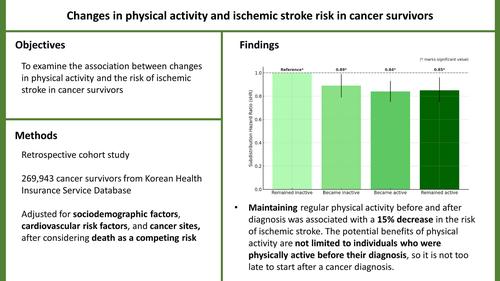Our official English website, www.x-mol.net, welcomes your feedback! (Note: you will need to create a separate account there.)
Association between physical activity changes and risk of incident ischemic stroke following cancer diagnosis: A nationwide retrospective cohort study
Cancer ( IF 6.2 ) Pub Date : 2024-05-09 , DOI: 10.1002/cncr.35361 Wonyoung Jung 1, 2 , In Young Cho 3, 4 , Jinhyung Jung 5 , Mi Hee Cho 6 , Hye Yeon Koo 7 , Yong‐Moon Mark Park 8, 9 , Be‐Long Cho 10 , Hyuktae Kwon 10 , Jin Ho Park 10 , Kyungdo Han 11 , Dong Wook Shin 3, 4
Cancer ( IF 6.2 ) Pub Date : 2024-05-09 , DOI: 10.1002/cncr.35361 Wonyoung Jung 1, 2 , In Young Cho 3, 4 , Jinhyung Jung 5 , Mi Hee Cho 6 , Hye Yeon Koo 7 , Yong‐Moon Mark Park 8, 9 , Be‐Long Cho 10 , Hyuktae Kwon 10 , Jin Ho Park 10 , Kyungdo Han 11 , Dong Wook Shin 3, 4
Affiliation

|
BackgroundPhysical inactivity is prevalent after cancer treatment, which could increase ischemic stroke risk in cancer survivors. This study investigated the association between physical activity change from pre‐ to post‐diagnosis and ischemic stroke risk among cancer survivors.MethodsUsing data from the Korean National Health Insurance Service database, 269,943 cancer survivors (mean [SD] age, 56.3 [12.1] years; 45.7% male) with no history of cardiovascular disease were evaluated based on changes in physical activity from pre‐ to post‐diagnosis. Using the Fine‐Gray model, subdistribution hazard ratios (sHRs) and 95% confidence intervals (CIs) for ischemic stroke risk were calculated, considering death as a competing risk.ResultsAfter cancer diagnosis, 62.0% remained inactive, 10.1% remained active, 16.6% became active, and 11.4% became inactive. During a mean (SD) follow‐up of 4.1 (2.0) years, being active both pre‐ and post‐diagnosis was associated with a 15% decreased risk of ischemic stroke (sHR, 0.85; 95% CI, 0.75–0.96), compared with those who remained inactive. Cancer survivors who became active and inactive post‐diagnosis showed a 16% and 11% lower ischemic stroke risk (sHR, 0.84; 95% CI, 0.75–0.93; sHR, 0.89; 95% CI, 0.79–0.99), respectively, than those who remained inactive. Analysis by the primary cancer site did not substantially differ from the main findings.ConclusionsPhysical activity is associated with reduced ischemic stroke risk among cancer survivors. The potential benefits of physical activity are not limited to individuals who were physically active before cancer diagnosis, thus preventive strategies against ischemic stroke should emphasize physical activity throughout the cancer journey.
中文翻译:

癌症诊断后体力活动变化与缺血性中风发生风险之间的关联:一项全国性回顾性队列研究
背景癌症治疗后缺乏身体活动很普遍,这可能会增加癌症幸存者缺血性中风的风险。本研究调查了癌症幸存者从诊断前到诊断后体力活动变化与缺血性中风风险之间的关联。方法使用韩国国民健康保险服务数据库的数据,269,943 名癌症幸存者(平均 [SD] 年龄,56.3 [12.1] 岁) ; 45.7% 男性)没有心血管疾病史,根据诊断前和诊断后身体活动的变化进行评估。使用 Fine-Gray 模型,计算缺血性中风风险的次分布风险比 (sHR) 和 95% 置信区间 (CI),将死亡视为竞争风险。结果癌症诊断后,62.0% 保持不活动,10.1% 保持活动,16.6 % 变得活跃,11.4% 变得不活跃。在平均 (SD) 4.1 (2.0) 年的随访期间,诊断前和诊断后保持活跃与缺血性中风风险降低 15% 相关(sHR,0.85;95% CI,0.75-0.96),与那些保持不活动的人相比。诊断后变得活跃和不活跃的癌症幸存者的缺血性中风风险分别比对照组低 16% 和 11%(sHR,0.84;95% CI,0.75–0.93;sHR,0.89;95% CI,0.79–0.99)。那些仍然不活跃的人。原发癌症部位的分析与主要发现没有显着差异。结论体育活动与癌症幸存者缺血性中风风险降低相关。体力活动的潜在好处不仅限于在癌症诊断前进行体力活动的人,因此缺血性中风的预防策略应在整个癌症旅程中强调体力活动。
更新日期:2024-05-09
中文翻译:

癌症诊断后体力活动变化与缺血性中风发生风险之间的关联:一项全国性回顾性队列研究
背景癌症治疗后缺乏身体活动很普遍,这可能会增加癌症幸存者缺血性中风的风险。本研究调查了癌症幸存者从诊断前到诊断后体力活动变化与缺血性中风风险之间的关联。方法使用韩国国民健康保险服务数据库的数据,269,943 名癌症幸存者(平均 [SD] 年龄,56.3 [12.1] 岁) ; 45.7% 男性)没有心血管疾病史,根据诊断前和诊断后身体活动的变化进行评估。使用 Fine-Gray 模型,计算缺血性中风风险的次分布风险比 (sHR) 和 95% 置信区间 (CI),将死亡视为竞争风险。结果癌症诊断后,62.0% 保持不活动,10.1% 保持活动,16.6 % 变得活跃,11.4% 变得不活跃。在平均 (SD) 4.1 (2.0) 年的随访期间,诊断前和诊断后保持活跃与缺血性中风风险降低 15% 相关(sHR,0.85;95% CI,0.75-0.96),与那些保持不活动的人相比。诊断后变得活跃和不活跃的癌症幸存者的缺血性中风风险分别比对照组低 16% 和 11%(sHR,0.84;95% CI,0.75–0.93;sHR,0.89;95% CI,0.79–0.99)。那些仍然不活跃的人。原发癌症部位的分析与主要发现没有显着差异。结论体育活动与癌症幸存者缺血性中风风险降低相关。体力活动的潜在好处不仅限于在癌症诊断前进行体力活动的人,因此缺血性中风的预防策略应在整个癌症旅程中强调体力活动。






























 京公网安备 11010802027423号
京公网安备 11010802027423号